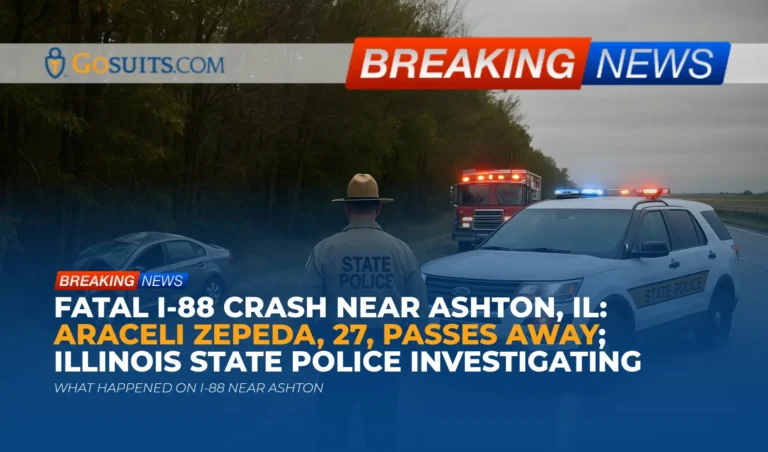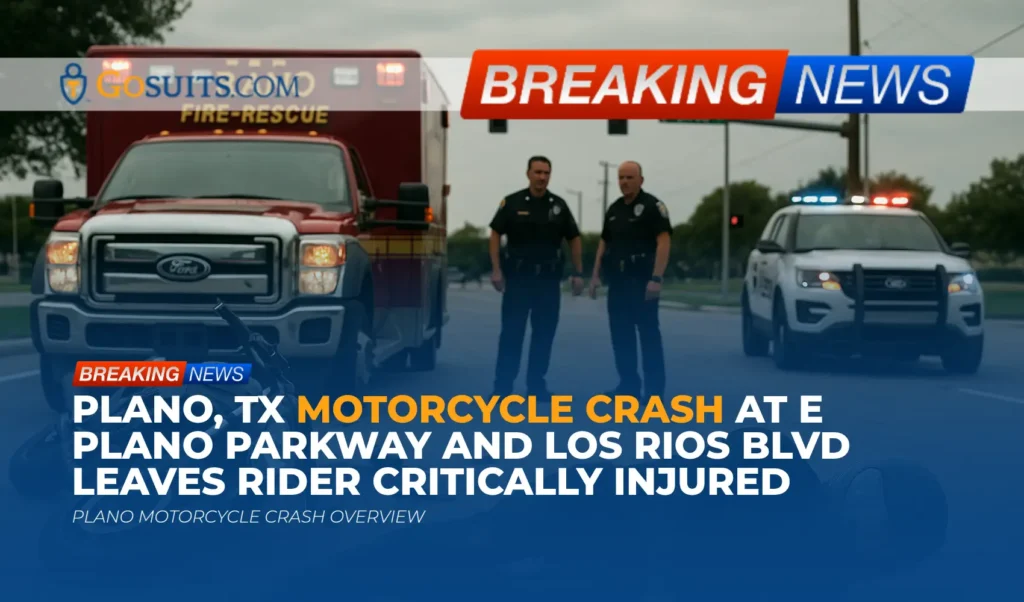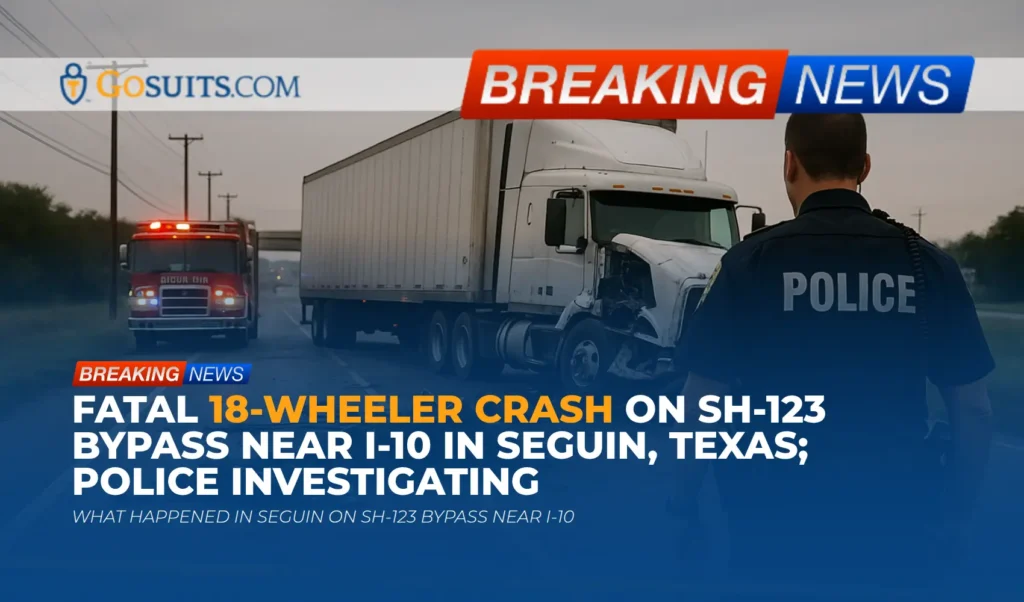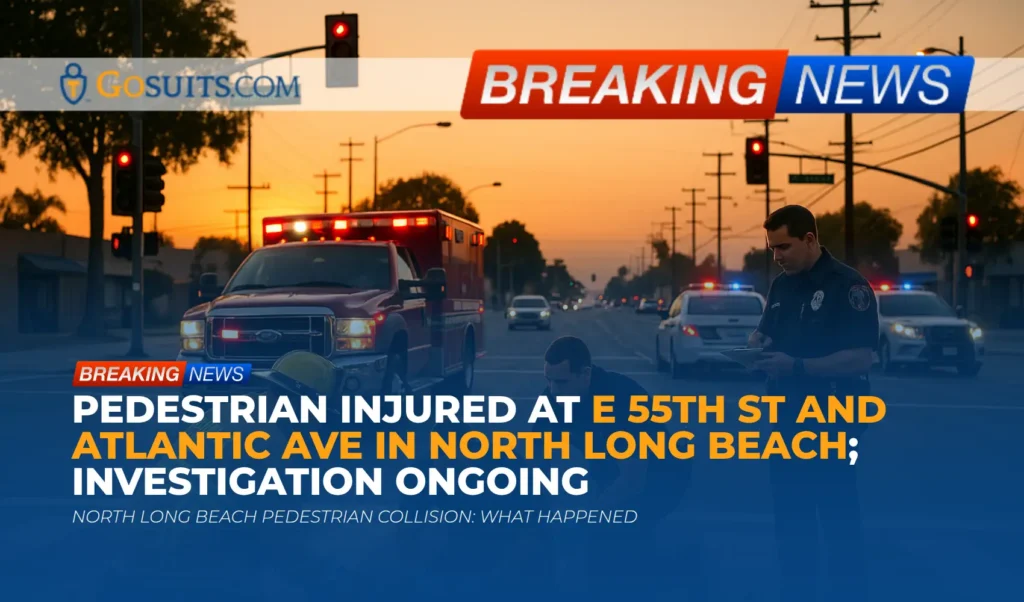- What Happened on I-88 Near Ashton
- Agencies Involved and the Status of the Investigation
- How Families Can Obtain Key Records and Reports
- Potential Civil Liability and Rights Under Illinois Law
- Insurance Considerations After a Fatal Highway Collision
- Time Limits and Notice Requirements in Illinois
- Evidence in Interstate Collisions and Preservation
- Safety Context: Run-off-road and Fixed Object Crashes
- Commentary from Gosuits Ashton, Illinois Personal Injury Attorney
- Action Steps That Cannot Wait
- Sources
What Happened on I-88 Near Ashton
According to information released publicly, a 27-year-old Rochelle woman, identified as Araceli Zepeda, passed away following a serious motor vehicle crash on westbound I-88 near milepost 71, close to Ashton, Illinois. The collision occurred just before 9:30 a.m. on October 20. Officials reported that the vehicle carrying Ms. Zepeda was traveling west when it reportedly made contact with another vehicle, the driver lost control, and the vehicle entered a treeline. First responders from the Illinois State Police and the Rochelle Fire Department found Ms. Zepeda unresponsive. She was airlifted to a Rockford hospital for emergency treatment, but died later that evening at approximately 8 p.m. Troopers also reported that at least one other person was airlifted. The Illinois State Police are leading the investigation.
At this stage, only preliminary details are publicly known. The investigation will typically examine vehicle dynamics, roadway conditions, weather, potential contributing factors, and statements from involved drivers and witnesses. Out of respect for all involved, it is important to avoid speculation until the investigative process clarifies what happened and why.
Agencies Involved and the Status of the Investigation
The Illinois State Police are responsible for interstate crash investigations in this region and are handling this case. Their investigators often gather scene measurements, photographs, vehicle inspections, event data recorder downloads when applicable, and witness accounts. In multi-vehicle or run-off-road crashes, they may also consult reconstruction specialists to analyze speed, braking, and vehicle trajectories.
The Winnebago County Coroner’s Office reported the death. In Illinois, a coroner’s office generally assumes jurisdiction in deaths that occur within its county, which explains why Winnebago County authorities were involved after the patient was transported to and treated in Rockford. The coroner’s responsibilities may include determining cause and manner of death, coordinating any autopsy when indicated, and notifying next of kin.
Local fire and emergency medical services, including Rochelle Fire Department and air medical teams, provided on-scene triage, stabilization, and transport. Their records, including dispatch times and treatment summaries, can become important parts of the factual timeline in a civil claim.
How Families Can Obtain Key Records and Reports
After a fatal crash, official records can be vital for understanding what occurred and for any civil claim that may follow. Below are the primary sources and how they generally work in Illinois. Each agency may have specific procedures, identification requirements, and fees. Policies can change, so reviewing the current information on the linked government pages is recommended.
Illinois State Police Traffic Crash Report
The Illinois State Police maintain traffic crash reports and make qualified reports available through their crash report portal. Families and legal representatives typically need details like the date, location, and involved names to locate the report. There may be different versions of the report, including narratives, diagram pages, and, in more serious cases, specialized reconstruction materials that can take longer to finalize.
Learn more or start a request through the ISP Crash Reports page: https://isp.illinois.gov/CrashReports.
Coroner Records and Autopsy Reports
When a death is investigated by a coroner, families can often request certain documents such as a coroner’s report and, when performed, an autopsy report. Release of records may vary based on the status of related investigations. In Winnebago County, the county government website provides contact information and guidance for the coroner’s office. Start at the county homepage and navigate to the Coroner: https://wincoil.gov.
Some information may be requested under the Illinois Freedom of Information Act. Note that FOIA includes exemptions for certain records during ongoing investigations. For the statute text, see the Illinois FOIA at the Illinois General Assembly: https://www.ilga.gov/legislation/ilcs/ilcs3.asp?ActID=85&ChapterID=2.
Death Certificates
Certified death certificates are typically needed for estate and insurance matters. In Illinois, certificates can be obtained through local county offices or through the Illinois Department of Public Health’s Vital Records program. Guidance is available here: https://dph.illinois.gov/topics-services/birth-death-other-records.html.
Hospital and EMS Records
Medical and transport records provide critical details about injuries, treatment, and timing. Under federal privacy rules, a decedent’s personal representative, such as the executor or court-appointed administrator, may generally request protected health information relevant to the estate’s interests. The U.S. Department of Health and Human Services provides guidance on who qualifies as a personal representative under HIPAA: https://www.hhs.gov/hipaa/for-professionals/privacy/guidance/personal-representatives/index.html.
Dispatch Audio, 911 Records, and Photographs
Additional records may exist in the form of 911 call audio, computer-aided dispatch logs, and scene photographs or drone imagery. Some of these materials are held by state police or local dispatch centers and can be requested through appropriate channels. Availability and timing of release may be affected by active investigations and FOIA exemptions.
Potential Civil Liability and Rights Under Illinois Law
Because this was a multi-vehicle event followed by a loss of control and a run-off-road impact, multiple liability questions can arise. The investigation will look at the actions of each driver leading up to the collision. In civil cases, negligence may include speeding, unsafe lane changes, following too closely, distraction, impairment, or failure to keep a proper lookout. A separate inquiry sometimes considers roadway conditions or the presence and placement of fixed objects, but claims involving roadway design or maintenance raise additional notice and proof requirements and should be evaluated carefully.
Wrongful Death Claims
Under the Illinois Wrongful Death Act, a claim is brought for the benefit of the decedent’s next of kin by the personal representative of the estate. Available damages in such a claim may include losses suffered by the surviving family, such as the loss of society and certain financial losses. The statute is available at the Illinois General Assembly: https://www.ilga.gov/legislation/ilcs/ilcs3.asp?ActID=2033&ChapterID=59.

Survival Claims
In addition to wrongful death, Illinois law recognizes a survival action through the estate for harms the decedent experienced before death, which can include conscious pain and suffering and medical expenses. The survival provisions appear in the Illinois Probate Act, section commonly cited as 755 ILCS 5/27-6. The Probate Act is at: https://www.ilga.gov/legislation/ilcs/ilcs3.asp?ActID=2104&ChapterID=60.
Comparative Fault in Illinois
Illinois applies a modified comparative fault system. In general terms, a claimant’s recovery is reduced by their percentage of fault and barred if the claimant’s fault is more than 50 percent. This framework appears at 735 ILCS 5/2-1116, available here: https://www.ilga.gov/legislation/ilcs/fulltext.asp?DocName=073500050K2-1116. In a multi-vehicle crash, determining the relative share of responsibility often requires careful review of the crash report, physical evidence, and witness accounts.
Who Can Be Responsible
Civil responsibility can include one or more drivers whose negligence contributed to the crash sequence. In some cases, a vehicle owner, employer, or other entity may also be implicated depending on the facts. If a government unit is alleged to have contributed through roadway conditions, additional legal hurdles and tighter deadlines may apply, discussed further below.
It is important not to assign blame prematurely. The investigative process should be allowed to develop the facts, including vehicle data and professional reconstruction when available.
Insurance Considerations After a Fatal Highway Collision
Insurance coverage analysis is a central part of these cases. Multiple policies can be implicated, and the order and manner in which claims are made can significantly affect outcomes. In general, the following coverages may be involved:
- Liability coverage of at-fault drivers: Pays damages the insured is legally obligated to pay for bodily injury and death caused by negligence, up to policy limits.
- Uninsured and underinsured motorist coverage: May apply if a responsible driver lacks insurance or has insufficient limits. UM/UIM provisions can be complex and are highly policy-specific.
- Medical payments coverage: Optional in Illinois, it may help with certain medical costs regardless of fault, subject to policy terms.
- Health insurance and subrogation: Health plans that pay medical bills often seek reimbursement from any third-party recovery. Understanding reimbursement rights is important to avoid surprises later.
Before contacting any insurance company about the facts of the crash, it is generally wise to consult an attorney. Statements to insurers, particularly recorded or written statements, can be cited later and may be used to dispute liability or damages. An initial legal consultation can help clarify rights and obligations under the policies involved and identify the safest way to proceed.
Practical Steps Regarding Claims
- Identify all potentially applicable policies: This may include policies for every involved vehicle and driver, as well as household UM/UIM policies.
- Avoid detailed statements before legal guidance: Factual statements can be interpreted in ways that affect fault allocation. Insurance carriers act in their own financial interest.
- Preserve written communications: Keep copies of every letter, email, and claim note exchanged with insurers.
- Document out-of-pocket expenses: Track funeral expenses, travel, and other costs. These can be relevant in claims under Illinois law.
Time Limits and Notice Requirements in Illinois
Illinois law imposes deadlines for bringing civil claims. Missing a deadline can end a claim regardless of its merits. The following timelines are provided as general legal background with citations; specific circumstances can alter how these rules apply.
- Wrongful Death Act limitation: Generally, an action must be commenced within 2 years of death. See the Illinois Wrongful Death Act at 740 ILCS 180. Statutory text and related provisions are at: https://www.ilga.gov/legislation/ilcs/ilcs3.asp?ActID=2033&ChapterID=59.
- Personal injury limitations: A two-year limitation typically applies for personal injury claims, 735 ILCS 5/13-202: https://www.ilga.gov/legislation/ilcs/documents/073500050K13-202.htm.
- Claims involving local public entities: Many actions against local public entities or employees must be filed within 1 year, 745 ILCS 10/8-101: https://www.ilga.gov/legislation/ilcs/documents/074500100K8-101.htm.
These citations are provided for educational background. Application of any limitation period can depend on precise facts, including the identity of defendants, the nature of the claim, and whether special tolling provisions apply.
Evidence in Interstate Collisions and Preservation
Evidence tends to be most reliable when gathered early. In a crash like the one described on I-88, common sources of proof include:
- Official crash reports and diagrams: Prepared by the Illinois State Police, including narratives, measurements, and sometimes reconstruction results.
- Scene photographs and video: Taken by investigators, tow operators, or witnesses. Photos can capture tire marks, debris fields, and point-of-rest positions.
- Vehicle inspections and event data recorders: Many modern vehicles store pre-impact speed, braking, throttle, and seat belt status. Timely access and proper handling are essential.
- Witness statements: Independent accounts can help resolve disputed sequences like lane changes or sudden braking.
- Medical and EMS documentation: Establishes injury timelines and interventions, and can be central to survival damages analysis.
- Air medical and dispatch logs: Support the timing narrative and can corroborate when critical events occurred.
When multiple vehicles are involved, it can be important to send written preservation notices to vehicle owners and carriers to prevent loss of data and repairs that erase physical evidence. Early coordination with insurers and, when appropriate, joint inspections can help safeguard crucial information.
Safety Context: Run-off-road and Fixed Object Crashes
National highway safety agencies observe that run-off-road crashes into fixed objects like trees and utility poles are a persistent source of severe and fatal injuries. These events often involve high speeds and limited room for correction, particularly on interstates where vehicles depart the roadway following an earlier collision or avoidance maneuver. Fixed objects do not absorb energy the way modern crash barriers are designed to do, which makes the forces on occupants especially dangerous.
Federal resources explain that roadway departure crashes remain a significant share of traffic fatalities nationally. For background, see the Federal Highway Administration’s roadway departure safety materials: https://safety.fhwa.dot.gov/roadway_dept/. The National Highway Traffic Safety Administration also publishes Traffic Safety Facts on fixed-object and non-collision crash patterns as part of its crash data series: https://www.nhtsa.gov/crash-data-systems. While those publications speak in national terms, they highlight why a run-off-road impact into a treeline can be catastrophic even at ordinary highway speeds.
For communities along I-88, these reminders underscore the importance of seat belt use, safe following distances, attentive driving, and a cautious approach in congested conditions. None of these points are specific to the Ashton crash, but they reflect general risk factors seen repeatedly in serious interstate incidents.

Commentary from Gosuits Ashton, Illinois Personal Injury Attorney
Our hearts are with the family and loved ones of Araceli Zepeda, and with every person affected by this tragic crash near Ashton. This article is intended to offer general information and education about the civil process after a serious collision. It is not a substitute for guidance tailored to the facts of any particular situation.
Based on the publicly available details, this appears to have been a chain of events that began with contact between vehicles, followed by a loss of control and a run-off-road impact into a treeline. In the civil context, those facts typically prompt a careful evaluation of each driver’s actions before and during the crash sequence, along with objective evidence like scene measurements and vehicle data. The investigative process should answer key questions about the order of impacts, avoidance opportunities, and whether any external conditions played a role.
In our experience, insurers and corporate defendants often move quickly to shape the narrative in ways that limit their exposure. That can include requesting recorded statements, focusing on ambiguous details, or offering early but incomplete interpretations of the facts. Insurance companies know the rules, timelines, and policy language very well. Families navigating shock and grief may not, and that information gap can affect how claims are handled. Taking time to understand rights and obligations before engaging deeply with insurers can protect against avoidable missteps.
A free consultation can be an important step toward clarity. It allows a discussion about applicable laws, insurance coverages, deadlines, and evidence preservation without any commitment, and it helps identify a safe approach to communications with insurers while the investigation is still developing.
Action Steps That Cannot Wait
The following time-sensitive actions can make a real difference in preserving rights and ensuring a complete record. These are general steps intended to promote informed decision-making in the immediate aftermath of a serious crash.
- Secure official records: Obtain the Illinois State Police crash report when available through the state portal. Keep the incident number, date, and location handy to locate the file efficiently.
- Preserve vehicles and data: Request in writing that involved vehicles be held without alteration until inspections can occur and event data can be downloaded by qualified professionals.
- Gather photos and witness information: Save any scene photographs, video, and names with contact details for bystanders or motorists who witnessed the incident.
- Collect medical and transport documentation: Organize hospital records, EMS run sheets, air medical summaries, and discharge or pronouncement paperwork to maintain a clear timeline of care.
- Request coroner materials appropriately: Follow county procedures for autopsy and coroner reports, understanding there may be waiting periods during active investigations.
- Track expenses and communications: Keep a ledger of costs related to the incident and save every letter or email exchanged with insurers or agencies.
- Be cautious with insurer contacts: Seek legal guidance before providing recorded statements. What is said to an insurance company may be used later to contest fault or damages.
- Mind the deadlines: Illinois law imposes strict limitation periods. Early calendar tracking reduces the risk of missing a critical date.
Request Police Report Preserve Evidence Checklist Understand Illinois Deadlines Learn About UM/UIM Coverage
Sources
- Illinois State Police Crash Reports: https://isp.illinois.gov/CrashReports
- Illinois Wrongful Death Act, 740 ILCS 180: https://www.ilga.gov/legislation/ilcs/ilcs3.asp?ActID=2033&ChapterID=59
- Illinois Probate Act, 755 ILCS 5, Survival provisions: https://www.ilga.gov/legislation/ilcs/ilcs3.asp?ActID=2104&ChapterID=60
- Comparative Fault, 735 ILCS 5/2-1116: https://www.ilga.gov/legislation/ilcs/fulltext.asp?DocName=073500050K2-1116
- Personal Injury Limitation, 735 ILCS 5/13-202: https://www.ilga.gov/legislation/ilcs/documents/073500050K13-202.htm
- Local Public Entity Limitations, 745 ILCS 10/8-101: https://www.ilga.gov/legislation/ilcs/documents/074500100K8-101.htm
- Illinois Freedom of Information Act, 5 ILCS 140: https://www.ilga.gov/legislation/ilcs/ilcs3.asp?ActID=85&ChapterID=2
- U.S. Department of Health and Human Services, HIPAA Personal Representatives: https://www.hhs.gov/hipaa/for-professionals/privacy/guidance/personal-representatives/index.html
- Illinois Department of Public Health, Vital Records: https://dph.illinois.gov/topics-services/birth-death-other-records.html
- Federal Highway Administration, Roadway Departure Safety: https://safety.fhwa.dot.gov/roadway_dept/
- National Highway Traffic Safety Administration, Crash Data Systems overview: https://www.nhtsa.gov/crash-data-systems






